Verbena plants are known for their lovely florals, while lemon verbena is known for its herbal uses. Of course, the two plants are part of the same family – so what makes them so different? Read the information below to decipher the differences between the broader plant category and the specific uses of lemon verbena in everyday use.
| Verbena | Lemon Verbena | |
|---|---|---|
| Classification | Verbena officinalis; approximately 250+ species | Aloysia citrodora; one of many species in the Verbenaceae family |
| Description | Verbena are flowering plants that may be perennials or annuals, with small to medium flowers with five petals coming in white, pink, pale pink, lavender, blue, purple, red, or similar shades. | Lemon verbena is known primarily for its fragrant shiny green leaves that grow up to 4 inches in length. The leaves are aromatic without crushing and taste like lemon. |
| Uses | Verbena plants have been historically used to treat many ailments including, but not limited to lower urinary tract disorders, fluid retention around the heart, angina, gallbladder pain, arthritis pain, and anemia. The plants are also used ornamentally in gardens and containers. | Lemon verbena plants have long been used in both herbal remedies and in culinary settings. They are aesthetically attractive plants and may be used ornamentally, as well, but far less commonly so. |
| Origins and growing preferences | Verbenas are native to tropical and subtropical regions in the Americas, with some varieties originating in warmer climates in Europe. They need full sun, good air circulation, well-draining soil, and cannot live in clay or compacted soils. | Lemon verbena specifically originated in Peru, Chile, and Argentina, though it was brought back to Europe in the 1700s for culinary, herbal medicinal, and perfumery uses. The plant needs warm climates, proper drainage, aged compost in the soil, and water-soluble plant food. |
| Special features or fun facts | Verbena plants are known as vervain and grown for ornamentation and herbal remedies. | Lemon verbena were first used as air fresheners for homes in the 1700s in Europe, with heavy use in herbal medicine, cooking, and more. |
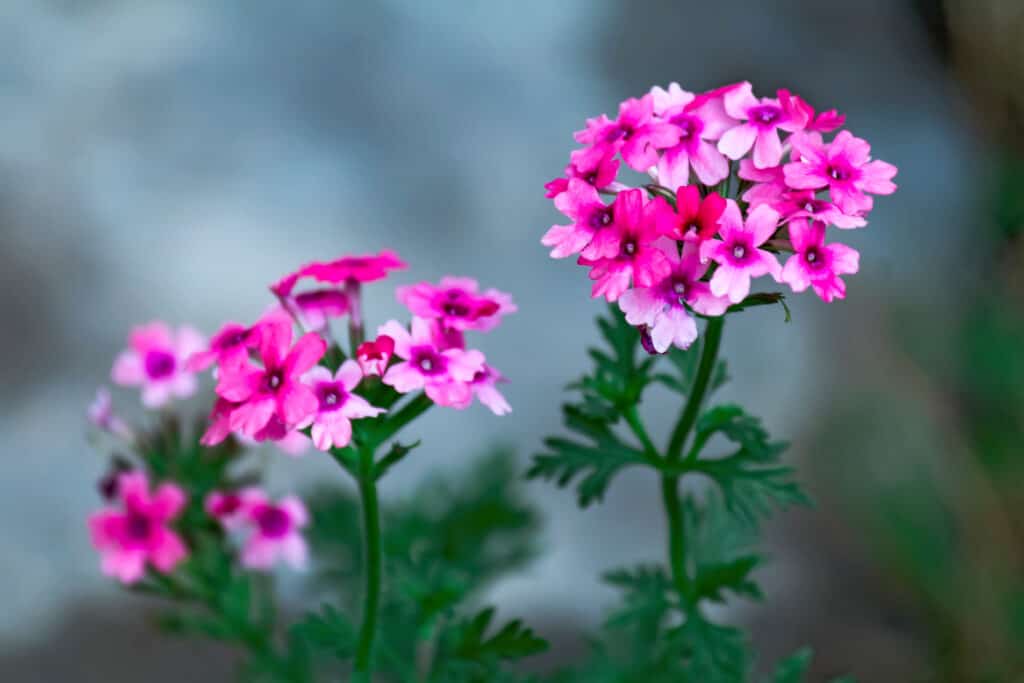
Verbena come in a wide range of colors.
©NeCoTi/Shutterstock.com
Key Differences Between Verbena and Lemon Verbena
Lemon verbena is technically in the same family as the plants commonly known as verbena, but this plant is primarily used for herbal uses, rather than floral ornamentation. The plants have other specific differences as well, which can help you determine which plant you’re looking to grow.
Verbena vs. Lemon Verbena: Classification
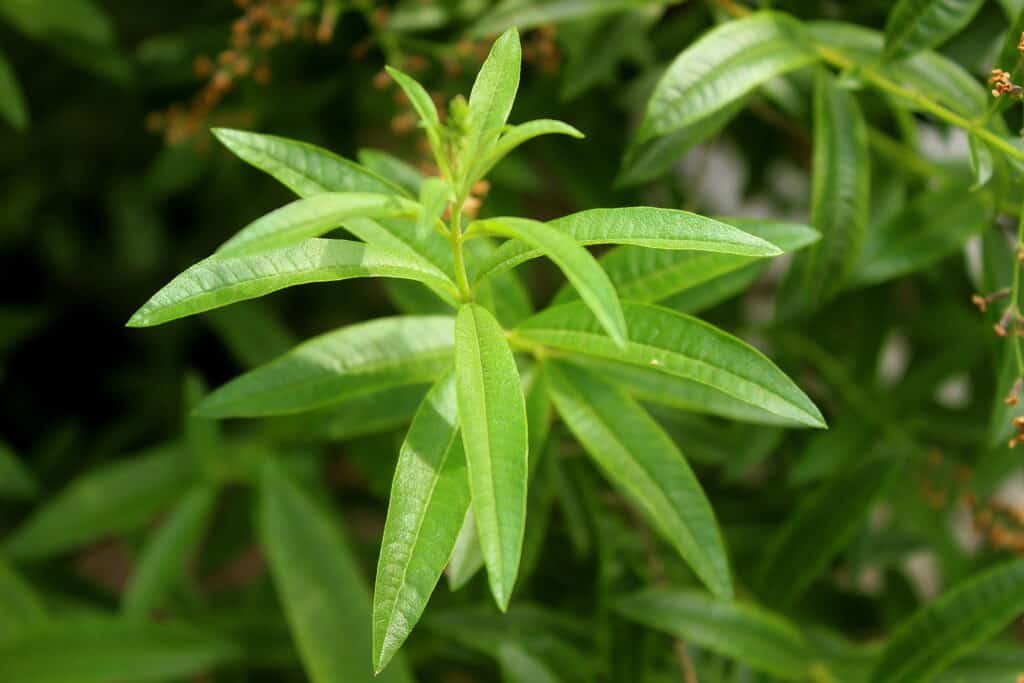
The delightfully fragrant leaves of the lemon verbena plant aren’t particularly unusual looking.
©Sander Steven Lang/Shutterstock.com
Verbena officinalis, or verbena plants, are a tropical, flowering herb native to warm climates in the Americas. They have been found growing wild in open areas, waste grounds, along the roadsides, in ditches, on mountain slopes, in pastures and meadows, and in cultivated fields. They’ve also been spotted in urban areas, railroad grounds, and shipyards. The plants are both perennial and annual, depending on the species and locale. Verbenas are part of the Verbenaceae family. There are about 250 species in the Verbenaceae family that are identified in the verbena genus.
Lemon verbena, or Aloysia citrodora, are part of this same family. Lemon verbena is an herbaceous perennial, an aromatic shrub. Other common names for lemon verbena include Lemon Beebrush and Herb Louisa.
Verbena vs. Lemon Verbena: Description
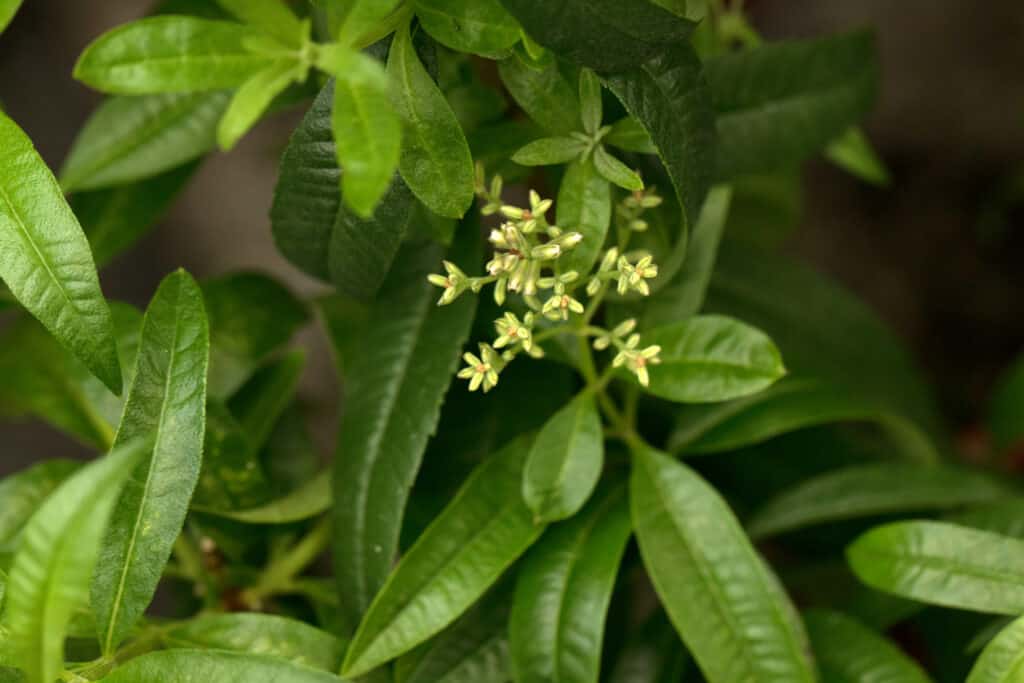
Lemon verbena do bloom, though the flowers are small and infrequent.
©Skyprayer2005/Shutterstock.com
The generic term Verbena refers to a variety of flowering plants. Most of the plants are perennials, though some are annuals, depending on the specific species or region in which they are grown. The flowers of these lovely plants are small to medium-sized, with five petals, and come in many shades, ranging from white to pale pink, dark pink, red, lavender, blue, purple, and similar shades within these color families. The leaves on verbenas are usually opposite leaves with are toothed, lobed, or dissected. Some varieties of verbena flowers have square stems.
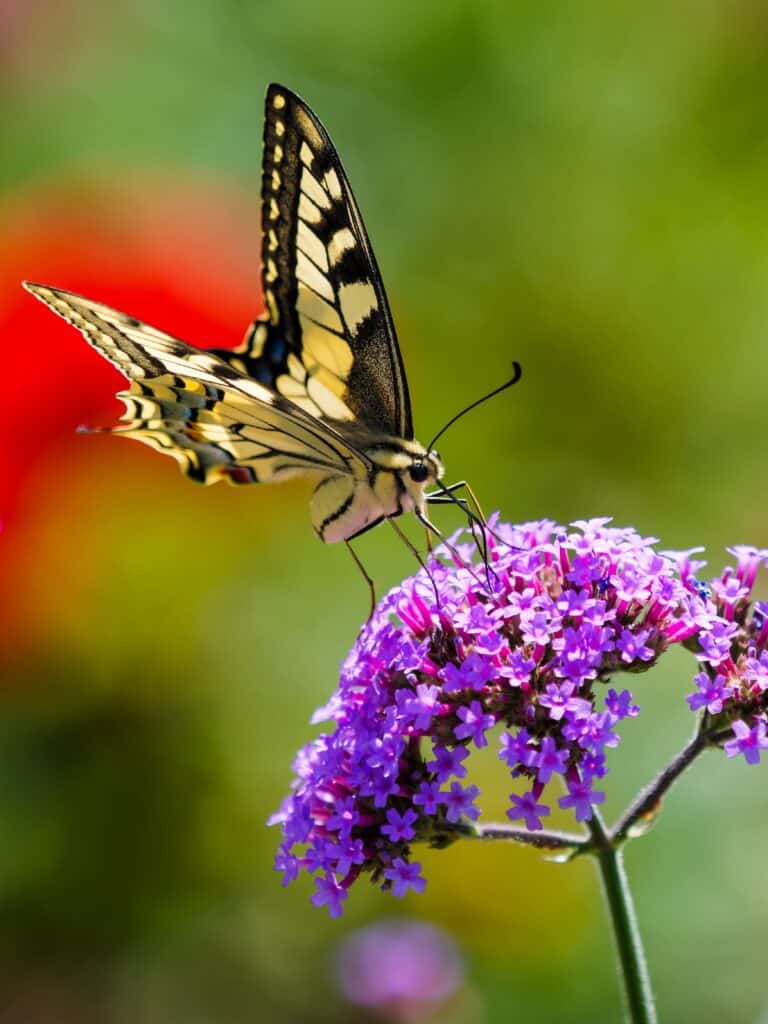
Verbena flowers are popular with pollinators.
©MacBen/Shutterstock.com
Lemon verbena, on the other hand, is more known for its leaves than for its flowers, though it will bloom, as well. The plant is a woody shrub and produces shiny green leaves that grow up to 4 inches in length. The leaves have a strong aroma without crushing them and they taste rather like lemon, earning the plant its name. The leaves are in whorls or three or opposites and the plants grow up to 15 feet in height in the outdoors in the wild. Indoors, they grow up to 4 feet tall in containers. The flowers are pale, lilac-colored flowers that bloom from mid-summer to early autumn, and many indoor and outdoor container plants never bloom.
Verbena vs. Lemon Verbena: Uses
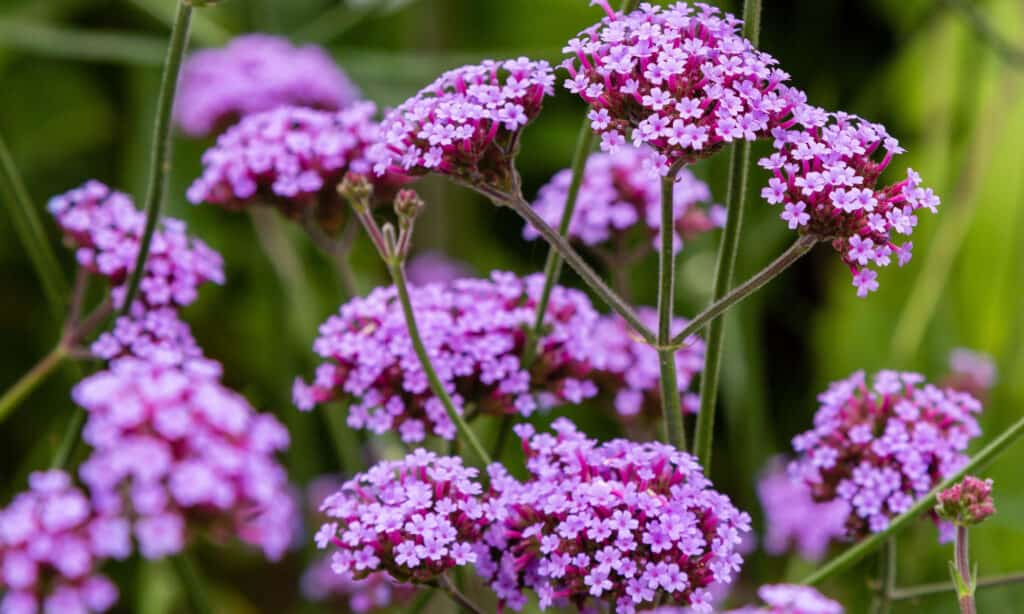
Verbena flowers come in a wide range of colors.
©Flower_Garden/Shutterstock.com
Verbena plants come in under about 250 different species, which means they are plentiful the world over. Of course, the question is whether or not the plants are useful for humans and what kinds of uses they have. Verbenas, that is the broader plant category that is primarily used for flowering, has been used for many years in the herbal medicine industry. It has been used for sore throats and respiratory tract diseases like whooping cough and asthma. Verbena has also been used to treat chest pain (angina), fluid retention around the heart, depression, seizures, gallbladder pain, arthritis pain and inflammation, metabolic disorders, anemia, fevers, hysteria, and fever recovery.
It has been used to treat nervous conditions, exhaustion, muscle spasms, digestive tract disorders, liver diseases and jaundice, kidney and lower urinary tract disorders, and other pains. It has also been used for treating menopausal symptoms, irregular menstruation, and improving milk production for breast feeding women. Some also have applied it to skin conditions such as poorly healing wounds and abscesses and burns. Others have gargled it for mouth sores and cold symptoms.
Looking at all that, it’s clear that verbena has a long history of being used in supplements and herbal medications across the planet. The plant is also attractive and often used for hanging plants, container gardens, traditional garden beds, and indoor plants.

Lemon verbena plants are usually selected for their culinary use, but the flowers do add some aesthetics.
©ChWeiss/Shutterstock.com
Lemon verbena is one of the plants in the verbena family and has been used for many of the same issues, however it has more specific treatments and uses. Some of those additional uses are primarily in play because of the fragrant nature of lemon verbena, such as essential oils, perfumery, deodorizers, and similar uses.
For medicinal uses, lemon verbena has been consistently used for mild digestive disorders and symptoms such as diarrhea and gas, and more severe conditions like insomnia and multiple sclerosis. There are specific scientific studies, however, that give foundation for these uses.
Lemon verbena leaves are edible and often used in culinary uses like garnishes, pestos, salsas, vinaigrettes, marinades for meats and vegetables, tossed into salads, added to soups, and added into ceviche. The leaves are often reduced into oils, syrups, sugars, and added as flavoring for jellies, jams, fruit glazes, and used as top off flavorings for things like crème brulée, ice cream, panna cotta, pudding, sorbets, and tarts. The plant is used to flavor lemonades and mixed drinks, and, of course, is used to make teas of various types.
Verbena vs. Lemon Verbena: Origins and Growing Preferences
Both verbenas in the verbena and the glandularia genera of the Verbenaceae family are native to tropical and subtropical regions in the Americas. They are among 250 species of plants that flower and are grown as either annuals or perennials (mostly perennials), depending on the variety or species. There are some varieties that originated in Europe, too, though, which are generally found in the Mediterranean regions. Because of their history in use as herbal plants, they’ve been grown all over the world in various gardens to make them available for herbal medicines.
Verbena plants need to be located in situations with good air circulation and at least 6 to 8 hours of full sun per day. They should be planted in loose soil, 12 to 18 inches apart, at depths of 6 to 12 inches. They needed soil amended with compost, in moderately moist soil, though they can endure some drought conditions. They can adapt to a variety of soil types as well, though, if the soil is well-drained. They should not be planted in clay or compacted soils, however, as these will lead to root rot. Keep the plants moist, but avoid over watering them, allowing the soil to dry between waterings. Fertilize verbenas with slow-release, all-purpose fertilizer according to the package directions, about once a month during growing season. Be sure to deadhead the spent flowers and trim back groundcover or trailing verbenas to stimulate prolonged growth.

Verbena flowers come in many shades and typically have five petals.
©Skyprayer2005/Shutterstock.com
Lemon verbena also originated in South America primarily, as a member of the tropical family in the Verbena herbals. Specifically, lemon verbena was first cultivated in Argentina, Peru, and Chile. The plant was transported to England during the Victorian era and used in English gardens and Spanish gardens after they were brought back from South America. The plant was first used in homes for refreshment, thanks to its lovely fragrance, but later was used in various other ways (skin care, teas, etc.) which helped to expand and spread its popularity. Specifically, the herb was used in English culinary settings from its introduction onward in the 1700s, with the plant migrating to the United States with immigrants as they came. Now, the plant is grown all over the world for its herbal and fragrance properties, cultivated throughout Europe, Australia, Northern Africa, Asia, North America, South America, and New Zealand.
Lemon verbena is very strongly a tropical and subtropical only plant, meaning it needs warm weather or indoor growing conditions. This means it can thrive in a greenhouse (small or large) and can succeed in your indoor home herb garden. If planting outdoors, it should be planted in the spring after the last frost has passed. Plant the plants 12 to 18 inches apart in full sun with fertile soil. Be sure the soil has excellent drainage. Many choose to plant lemon verbena in containers for these various needs. Add some aged compost and rich organic matter to boost the soil and feed the plants water-soluble plant food for the most productive results. Keep the soil moist, watering every time the top 2 inches of soil dries out, but avoid over watering as the roots will rot or mildew. Harvest the leaves of your lemon verbena whenever they are large enough to use.
Verbena vs. Lemon Verbena: Special Features and Fun Facts

Lemon verbena is commonly used in essential oils. Beware that essential oils are typically unsafe for pets.
©AmyLv/Shutterstock.com
Verbenas are commonly known as vervain and are among 250 different species in the family. They can actually be grown as either perennials or annuals, depending on the location and specific species. Verbenas are typically grown for ornamental purposes, while lemon verbenas are grown for their herbal uses more commonly. Technically, both are flowering plants, but because of that fragrant aroma from the lemon verbena, it’s favored for its aroma instead of its good looks. Lemon verbena was used as an air freshener in homes, added to baths, potpourris, soaps, and oils, and refreshing finger bowls in the Victorian era. Lemon verbena is also said to symbolize sensitivity.
Next Up:
- 4 Annual Flowers that Bloom All Summer
- 15 Best Potted Annual Flowers to Attract Pollinators
- Discover 9 Unique and Eerie Supernatural Plants
- Roses in Texas: 6 Roses Perfect for Gardens
The photo featured at the top of this post is © MacBen/Shutterstock.com
Sources
- Missouri Botanical Garden, Available here: https://www.missouribotanicalgarden.org/PlantFinder/PlantFinderDetails.aspx?taxonid=291522
- Specialty Produce, Available here: https://specialtyproduce.com/produce/Lemon_Verbena_3171.php
- Britannica, Available here: https://www.britannica.com/plant/verbena-plant
- WebMD, Available here: https://www.webmd.com/vitamins/ai/ingredientmono-632/lemon-verbena
- WebMD, Available here: https://www.webmd.com/vitamins/ai/ingredientmono-88/verbena
- RX List, Available here: https://www.rxlist.com/verbena/supplements.htm
- Proven Winners, Available here: https://www.provenwinners.com/learn/how-plant/verbena
- Cabi, Available here: https://www.cabi.org/isc/datasheet/56184
- Bonnie Plants, Available here: https://bonnieplants.com/blogs/how-to-grow/growing-lemon-verbena
Thank you for reading! Have some feedback for us? Contact the AZ Animals editorial team.






